
The Borghese Vase is a monumental bell-shaped krater sculpted in Athens from Pentelic marble in the second half of the 1st century BC as a garden ornament for the Roman market; [1] it is now in the Louvre Museum. [2]

The Borghese Vase is a monumental bell-shaped krater sculpted in Athens from Pentelic marble in the second half of the 1st century BC as a garden ornament for the Roman market; [1] it is now in the Louvre Museum. [2]
Standing 1.72 metres tall and with a diameter of 1.35 m., the vase has a deep frieze with bas-reliefs and an everted gadrooned lip over a gadrooned lower section, where paired satyrs' heads mark the former placement of loop handles; [3] it stands on a spreading fluted stem with a cabled motif round its base, on a low octagonal plinth.
The frieze depicts the thiasus , an ecstatic Bacchanalian procession accompanying Dionysus, draped with the panther skin and playing the aulos, and Ariadne. However, the accompanying figures, often said to be satyrs, have neither the common characteristics of cloven feet nor equine tails flowing to the floor as typically shown on Greek pottery; some references identify the figures as sileni. The draped figures are often said to be Maenads but are clearly not: Maenads are females who accompany Dionysus but on the vase a draped male figure is depicted. One of the figures is shown being anointed, typically a symbolic act of divinity, leading to the interpretation of some of the figures as Apollo and Dionysus rescuing Silenus who is shown falling down reaching for a spilled flagon of wine. This scene on the vase corresponds to the saying "The Gods look after children and drunken men" which has been passed down orally through many generations. Many copies of the vase do not correctly depict the scene, replacing Dionysus with a female figure on the wrongful assumption that a sexual act is in progress.

The vase was rediscovered in a Roman garden that occupied part of the site of the gardens of Sallust [4] in 1566 and acquired by the Borghese family. Napoleon bought it from his brother-in-law Camillo Borghese in 1808, and it has been displayed in the Louvre since 1811.
In his capriccio shown below, the French artist Hubert Robert embellished and enlarged the Borghese Vase for dramatic effect and set it, in atmospherically ruinous condition, on the Aventine overlooking the Colosseum, a position it never occupied. Robert also painted it in several other settings, including the gardens of Versailles (L'entrée du Tapis Vert) with Marie Antoinette and Louis XVI. [5]

Often paired and rescaled to balance the slightly smaller Medici Vase, it is one of the most admired and influential marble vases from antiquity, forms that satisfied the Baroque and neoclassical approach to classical art alike. Three pairs were copied for the Bassin de Latone in the gardens of Versailles; alabaster pairs stand in the Great Hall at Houghton Hall, Norfolk; and bronze ones at Osterley Park, Middlesex. On a reduced scale, the vases made admirable wine coolers in silver, or in silver-gilt, as Paul Storr delivered them to the Prince Regent in 1808 (Haskell and Penny 1981:315). John Flaxman based a bas-relief on the frieze of the Borghese Vase (Sir John Soane's Museum, London). As decorative objects they have been reproduced through the eighteenth and nineteenth centuries [6] and remain popular subjects for imitation in bronze or porcelain, for example in Coade stone (a reduced-size Coade stone example dating from 1770-1771 stands in the Temple of Flora at Stourhead), [7] [8] and also in jasper ware by Josiah Wedgwood (c. 1790), who adapted the form of the Medici Vase for the bas-reliefs and provided it with a lid and a neoclassical drum pedestal.
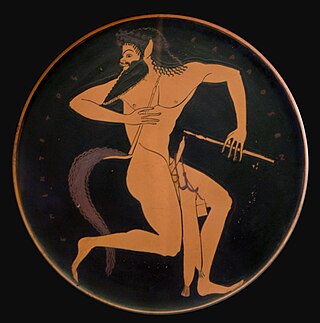
In Greek mythology, a satyr, also known as a silenus or silenos, and selini (plural), is a male nature spirit with ears and a tail resembling those of a horse, as well as a permanent, exaggerated erection. Early artistic representations sometimes include horse-like legs, but, by the sixth century BC, they were more often represented with human legs. Comically hideous, they have mane-like hair, bestial faces, and snub noses and they always are shown naked. Satyrs were characterized by their ribaldry and were known as lovers of wine, music, dancing, and women. They were companions of the god Dionysus and were believed to inhabit remote locales, such as woodlands, mountains, and pastures. They often attempted to seduce or rape nymphs and mortal women alike, usually with little success. They are sometimes shown masturbating or engaging in bestiality.

In Greek mythology, Silenus was a companion and tutor to the wine god Dionysus. He is typically older than the satyrs of the Dionysian retinue (thiasos), and sometimes considerably older, in which case he may be referred to as a Papposilenus. Silen and its plural sileni refer to the mythological figure as a type that is sometimes thought to be differentiated from a satyr by having the attributes of a horse rather than a goat, though usage of the two words is not consistent enough to permit a sharp distinction.

In Greek mythology and religion, the thiasus was the ecstatic retinue of Dionysus, often pictured as inebriated revelers. Many of the myths of Dionysus are connected with his arrival in the form of a procession. The grandest such version was his triumphant return from "India", which influenced symbolic conceptions of the Roman triumph and was narrated in rapturous detail in Nonnus' Dionysiaca. In this procession, Dionysus rides a chariot, often drawn by big cats such as tigers, leopards, or lions, or alternatively elephants or centaurs.

The life-size ancient but much restored marble statue known as the Barberini Faun, Fauno Barberini or Drunken Satyr is now in the Glyptothek in Munich, Germany. A faun is the Roman equivalent of a Greek satyr. In Greek mythology, satyrs were human-like male woodland spirits with several animal features, often a goat-like tail, hooves, ears, or horns. Satyrs attended Dionysus.

The Medici Vase is a monumental marble bell-shaped krater sculpted in Athens in the second half of the 1st century AD as a garden ornament for the Roman market. It is now in the Uffizi Gallery in Florence.
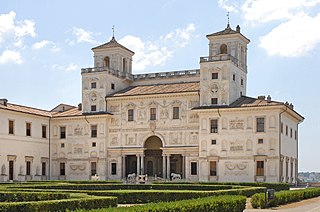
The Villa Medici is a Mannerist villa and an architectural complex with a garden contiguous with the larger Borghese gardens, on the Pincian Hill next to Trinità dei Monti in Rome, Italy. The Villa Medici, founded by Ferdinando I de' Medici, Grand Duke of Tuscany and now property of the French State, has housed the French Academy in Rome since 1803. A musical evocation of its garden fountains features in Ottorino Respighi's Fountains of Rome.

Giovanni Francesco (Gianfrancesco) Susini was a Mannerist Florentine sculptor in bronze and marble.
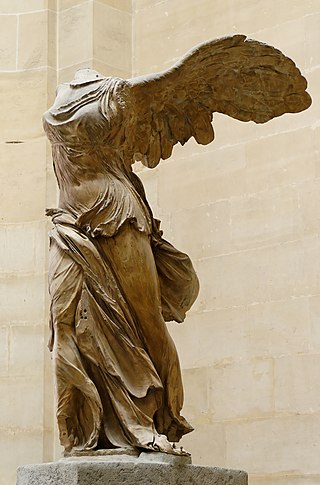
Hellenistic art is the art of the Hellenistic period generally taken to begin with the death of Alexander the Great in 323 BC and end with the conquest of the Greek world by the Romans, a process well underway by 146 BC, when the Greek mainland was taken, and essentially ending in 30 BC with the conquest of Ptolemaic Egypt following the Battle of Actium. A number of the best-known works of Greek sculpture belong to this period, including Laocoön and His Sons, Venus de Milo, and the Winged Victory of Samothrace. It follows the period of Classical Greek art, while the succeeding Greco-Roman art was very largely a continuation of Hellenistic trends.
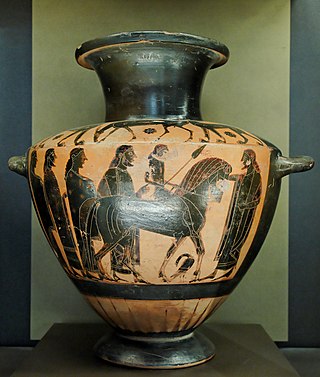
Lydos was an Attic vase painter in the black-figure style. Active between about 560 and 540 BC, he was the main representative of the "Lydos Group". His signature, ό Λυδός, ho Lydos, inscribed on two vases, is informative regarding the cultural background of the artist. Either he immigrated to Athens from the Lydian Empire of King Kroisos, or he was born in Athens as the son of Lydian parents. In any case, he learned his trade in Athens.
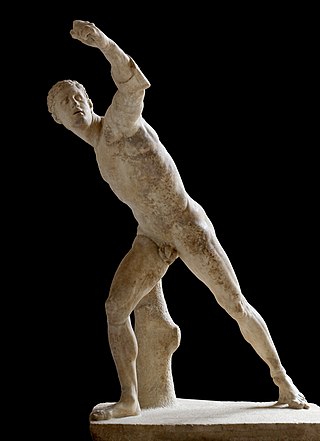
The Borghese Gladiator is a Hellenistic life-size marble sculpture portraying a swordsman, created at Ephesus about 100 BC, now on display at the Louvre.

The Sleeping Hermaphrodite is an ancient marble sculpture depicting Hermaphroditus life size. In 1620, Italian artist Gian Lorenzo Bernini sculpted the mattress upon which the statue now lies. The form is partly derived from ancient portrayals of Venus and other female nudes, and partly from contemporaneous feminised Hellenistic portrayals of Dionysus/Bacchus. It represents a subject that was much repeated in Hellenistic times and in ancient Rome, to judge from the number of versions that have survived. Discovered at Santa Maria della Vittoria, Rome, the Sleeping Hermaphrodite was immediately claimed by Cardinal Scipione Borghese and became part of the Borghese Collection. The "Borghese Hermaphrodite" was later sold to the occupying French and was moved to The Louvre, where it is on display.

The Derveni Krater is a volute krater, the most elaborate of its type, discovered in 1962 in a tomb at Derveni, not far from Thessaloniki, and displayed at the Archaeological Museum of Thessaloniki. Weighing 40 kg, it is made of a bronze with a high tin content of about 15%, which endows it with a superb golden sheen without use of any gold at all. It is dated to the 4th century BC, and was probably made in Athens. Large metalwork vessels are extremely rare survivals in Ancient Greek art, and the Derveni Krater is the outstanding survival from Hellenistic art, as the Vix Krater is from the Archaic period.

The Crouching Venus is a Hellenistic model of Venus surprised at her bath. Venus crouches with her right knee close to the ground, turns her head to the right and, in most versions, reaches her right arm over to her left shoulder to cover her breasts. To judge by the number of copies that have been excavated on Roman sites in Italy and France, this variant on Venus seems to have been popular.

The Resting Satyr or Leaning Satyr, also known as the Satyr anapauomenos is a statue type generally attributed to the ancient Greek sculptor Praxiteles. Some 115 examples of the type are known, of which the best known is in the Capitoline Museums.

The Sleeping Ariadne, housed in the Vatican Museums in Vatican City, is a Roman Hadrianic copy of a Hellenistic sculpture of the Pergamene school of the 2nd century BC, and is one of the most renowned sculptures of Antiquity. The reclining figure in a chiton bound under her breasts half lies, half sits, her extended legs crossed at the calves, her head pillowed on her left arm, her right thrown over her head. Other Roman copies of this model exist: one, the "Wilton House Ariadne", is substantially unrestored, while another, the "Medici Ariadne" found in Rome, has been "seriously reworked in modern times", according to Brunilde Sismondo Ridgway. Two surviving statuettes attest to a Roman trade in reductions of this familiar figure. A variant Sleeping Ariadne is in the Prado Museum, Madrid. A later Roman variant found in the Villa Borghese gardens, Rome, is at the Louvre Museum.

The Torlonia Vase or Cesi-Albani-Torlonia Vase is a colossal and celebrated neo-Attic Roman white marble vase, 1.8 m tall, made in the 1st century BCE, which has passed through several prominent collections of antiquities before coming into the possession of the Princes Torlonia in Rome.

Python was a Greek vase painter in the city of Poseidonia in Campania, Southern Italy, one of the major cities of Magna Graecia in the fourth Century BC. Together with his close collaborator and likely master Asteas, Python is one of only two vase painters from Southern Italy whose names have survived on extant works. It has even been suggested that the joint workshop of Asteas and Python in Paestum was a family business.
The hoplites were soldiers from Ancient Greece who were usually free citizens. They had a very uniform and distinct appearance; specifically they were armed with a spear (dory) in their right hand and a heavy round shield in their left.

The Athenian Band Cup is an Attic Greek kylix attributed to the Oakeshott Painter. It is further classified as a band cup, a type of Little-Master cup.

The Sosibios Vase is a Neo-Attic marble krater of the Hellenistic period. It is attributed by signature to Sosibios, a Greek sculptor who was active in Rome during the end of the Roman Republic, and is dated to approximately 50 BCE. It is Sosibios' only known work.